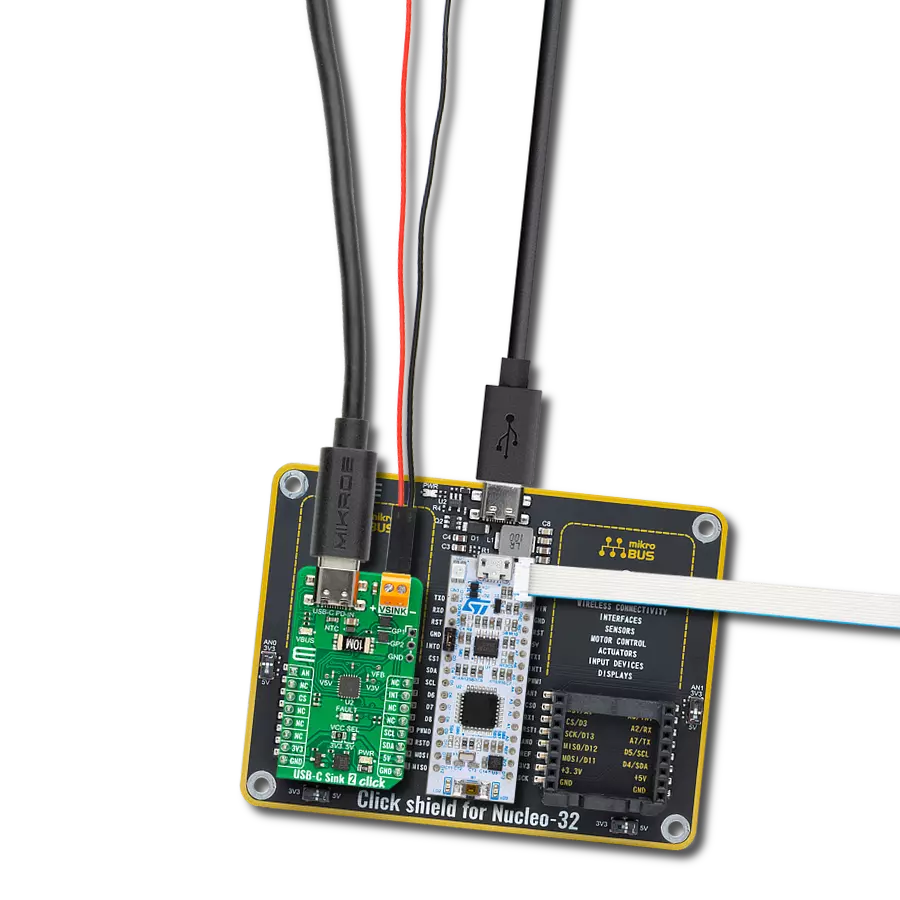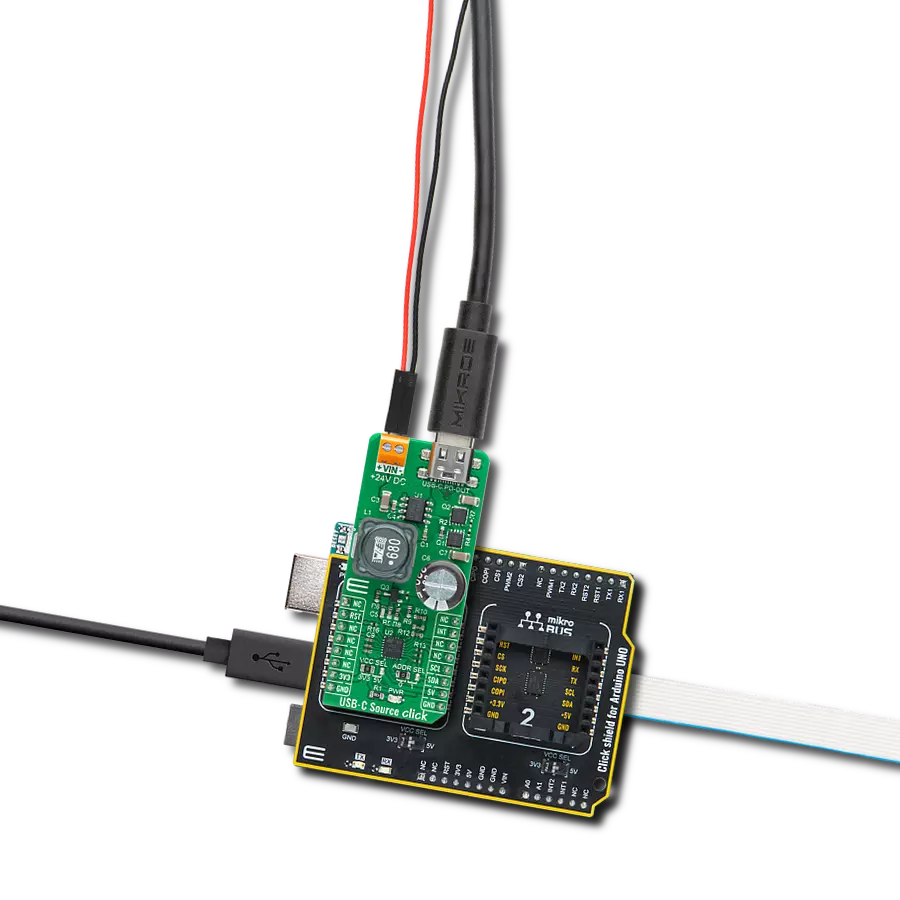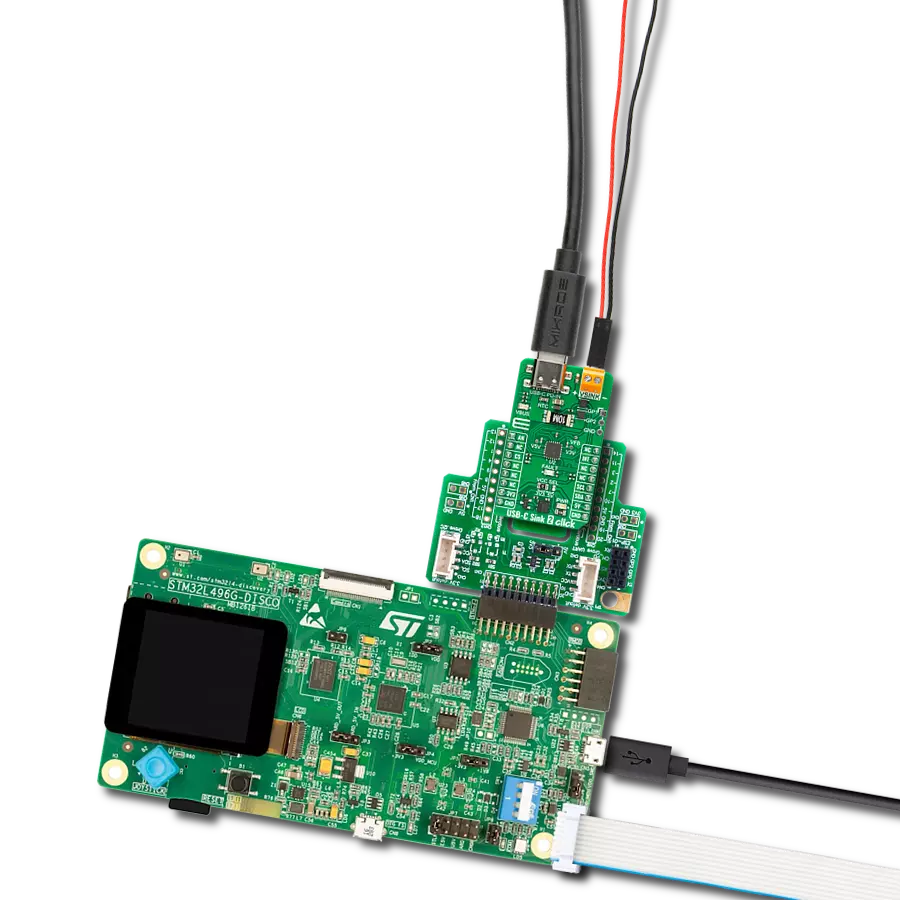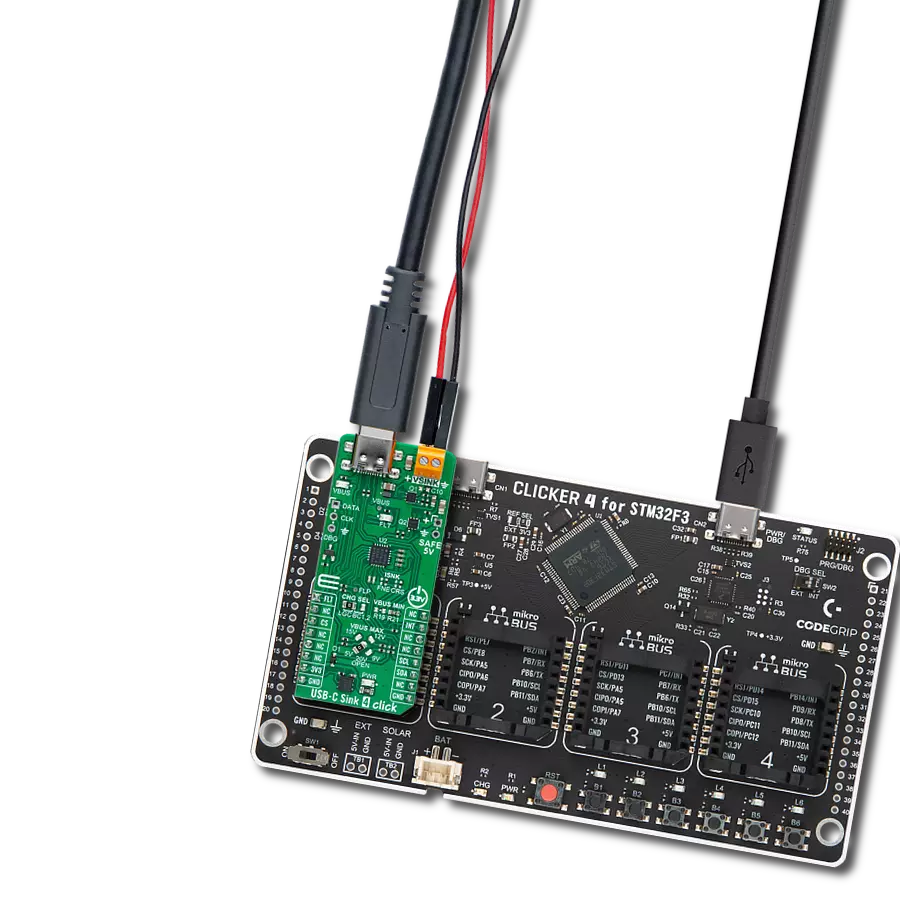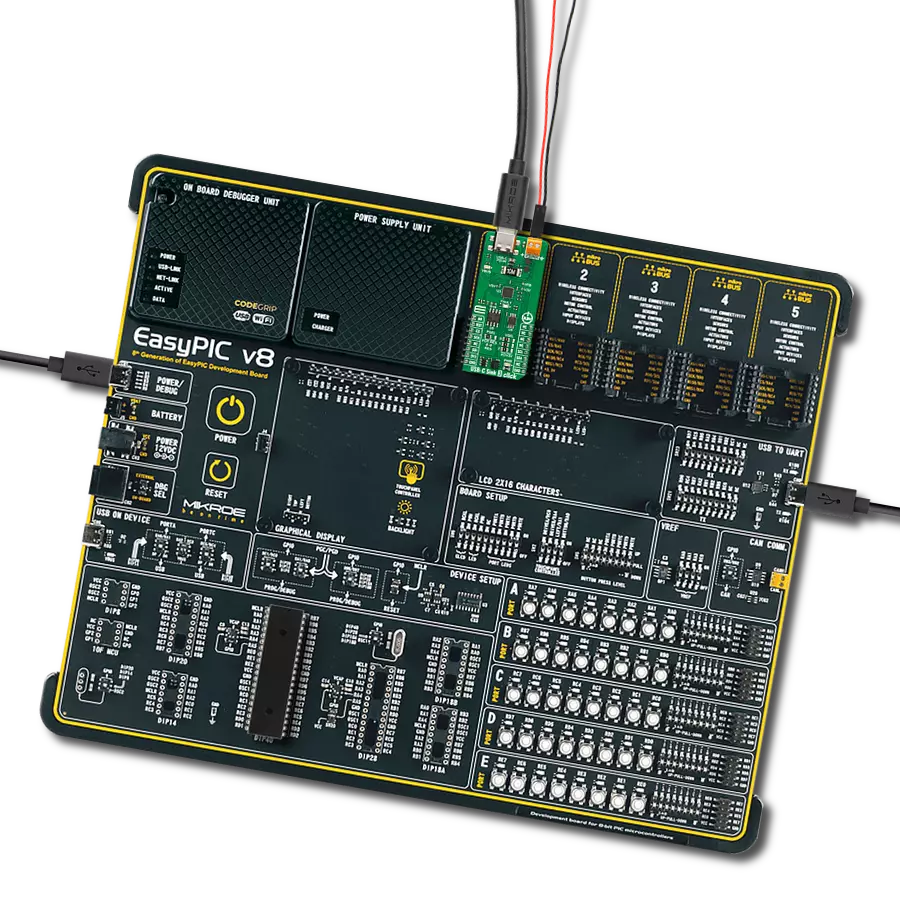Our USB Type-C PD controller unleashes the full potential of USB Type-C, allowing you to charge, transfer data, and connect to a world of peripherals like never before.
A
A
Hardware Overview
How does it work?
USB-C Power Click is based on the TPS25750S, a USB Type-C and Power Delivery (PD) controller from Texas Instruments, providing cable plug and orientation detection for a single USB Type-C connector. The TPS25750S communicates on the CC wire upon cable detection using the USB PD protocol. When cable detection and USB PD negotiation are complete, the TPS25750S enables the appropriate power path for sourcing or sinking power on the USB IN-OUT connector, depending on the set configuration. The TPS25750S is highly optimized for applications supporting USB-C PD Power and provides robust protection and fully managed internal power paths (5V/3A with 36mΩ sourcing switch). The second USB connector, marked with 5V IN, serves to supply 5V voltage in the form of a USB connection, which is necessary for the internal 5V sourcing power path. This Click board™ communicates with MCU using the standard I2C 2-Wire interface to read data and configure settings with a maximum frequency of 400kHz. In addition, it also possesses an additional
interrupt signal routed on the IRQ pin of the mikroBUS™ socket. Besides the I2C port for communication with the host MCU, the TPS25750S has one additional I2C interface in Master configuration with a maximum frequency of 400kHz, which will connect to the battery charger like BQ25792 for example (or external EEPROM), to communicate the proper configurations to set it up for charging mode, charging current, OTG mode, and many more. The BQ25792 is a fully integrated switch-mode buck-boost charger for 1-4 cell Li-ion and Li-polymer batteries, allowing users to source or sink high power up to 3A. The necessary power supply and lines for communication with the battery charger are located on unpopulated headers on the right side of the board. Thanks to the onboard ADC jumpers, the TPS25750S can set the dead battery configuration and the I2C slave address for the PD controller based on their position. Two offered dead battery configurations are Safe mode and Always Enable Sink. The Safe mode does not
enable the sink path, and USB PD is disabled until the configuration is loaded. In the Always Enable Sink mode, the device enables the sink path, regardless of the current amount the attached source offers. The USB PD is disabled until the configuration is loaded. This Click board™ also features two GPIO signals, located on unpopulated headers, that are user-defined for status and control information. GPIO pins can be mapped to USB Type-C, USB PD, and application-specific events to control other ICs, interrupt a host processor, or receive input from other ICs. Along with the GPIOs, it also has two LED indicators, IO0 and IO1, for the realization of visual detection of some anomalies or statuses during operation. This Click board™ can be operated only with a 3.3V logic voltage level. The board must perform appropriate logic voltage level conversion before using MCUs with different logic levels. Also, it comes equipped with a library containing functions and an example code that can be used as a reference for further development.
Features overview
Development board
PIC18F57Q43 Curiosity Nano evaluation kit is a cutting-edge hardware platform designed to evaluate microcontrollers within the PIC18-Q43 family. Central to its design is the inclusion of the powerful PIC18F57Q43 microcontroller (MCU), offering advanced functionalities and robust performance. Key features of this evaluation kit include a yellow user LED and a responsive
mechanical user switch, providing seamless interaction and testing. The provision for a 32.768kHz crystal footprint ensures precision timing capabilities. With an onboard debugger boasting a green power and status LED, programming and debugging become intuitive and efficient. Further enhancing its utility is the Virtual serial port (CDC) and a debug GPIO channel (DGI
GPIO), offering extensive connectivity options. Powered via USB, this kit boasts an adjustable target voltage feature facilitated by the MIC5353 LDO regulator, ensuring stable operation with an output voltage ranging from 1.8V to 5.1V, with a maximum output current of 500mA, subject to ambient temperature and voltage constraints.
Microcontroller Overview
MCU Card / MCU
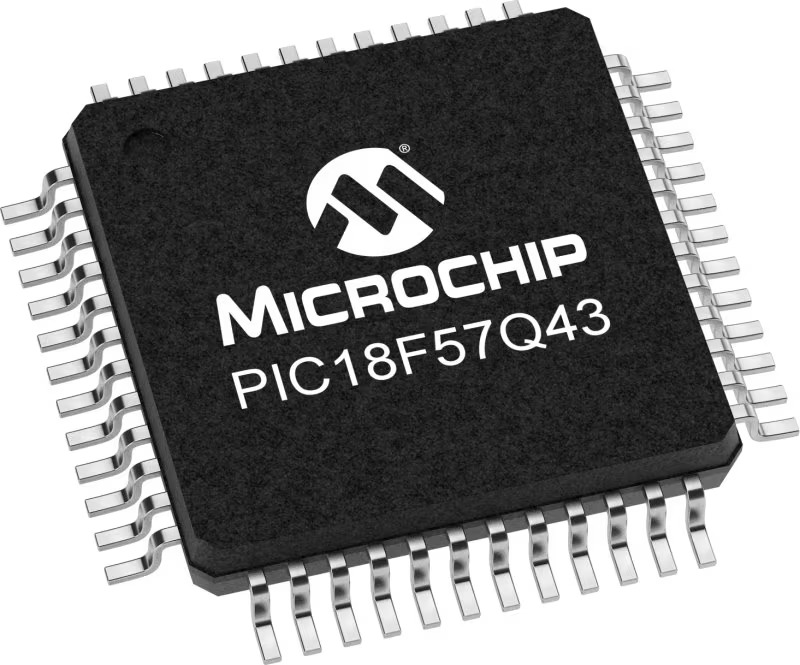
Architecture
PIC
MCU Memory (KB)
128
Silicon Vendor
Microchip
Pin count
48
RAM (Bytes)
8196
You complete me!
Accessories
Curiosity Nano Base for Click boards is a versatile hardware extension platform created to streamline the integration between Curiosity Nano kits and extension boards, tailored explicitly for the mikroBUS™-standardized Click boards and Xplained Pro extension boards. This innovative base board (shield) offers seamless connectivity and expansion possibilities, simplifying experimentation and development. Key features include USB power compatibility from the Curiosity Nano kit, alongside an alternative external power input option for enhanced flexibility. The onboard Li-Ion/LiPo charger and management circuit ensure smooth operation for battery-powered applications, simplifying usage and management. Moreover, the base incorporates a fixed 3.3V PSU dedicated to target and mikroBUS™ power rails, alongside a fixed 5.0V boost converter catering to 5V power rails of mikroBUS™ sockets, providing stable power delivery for various connected devices.
Used MCU Pins
mikroBUS™ mapper
Take a closer look
Click board™ Schematic
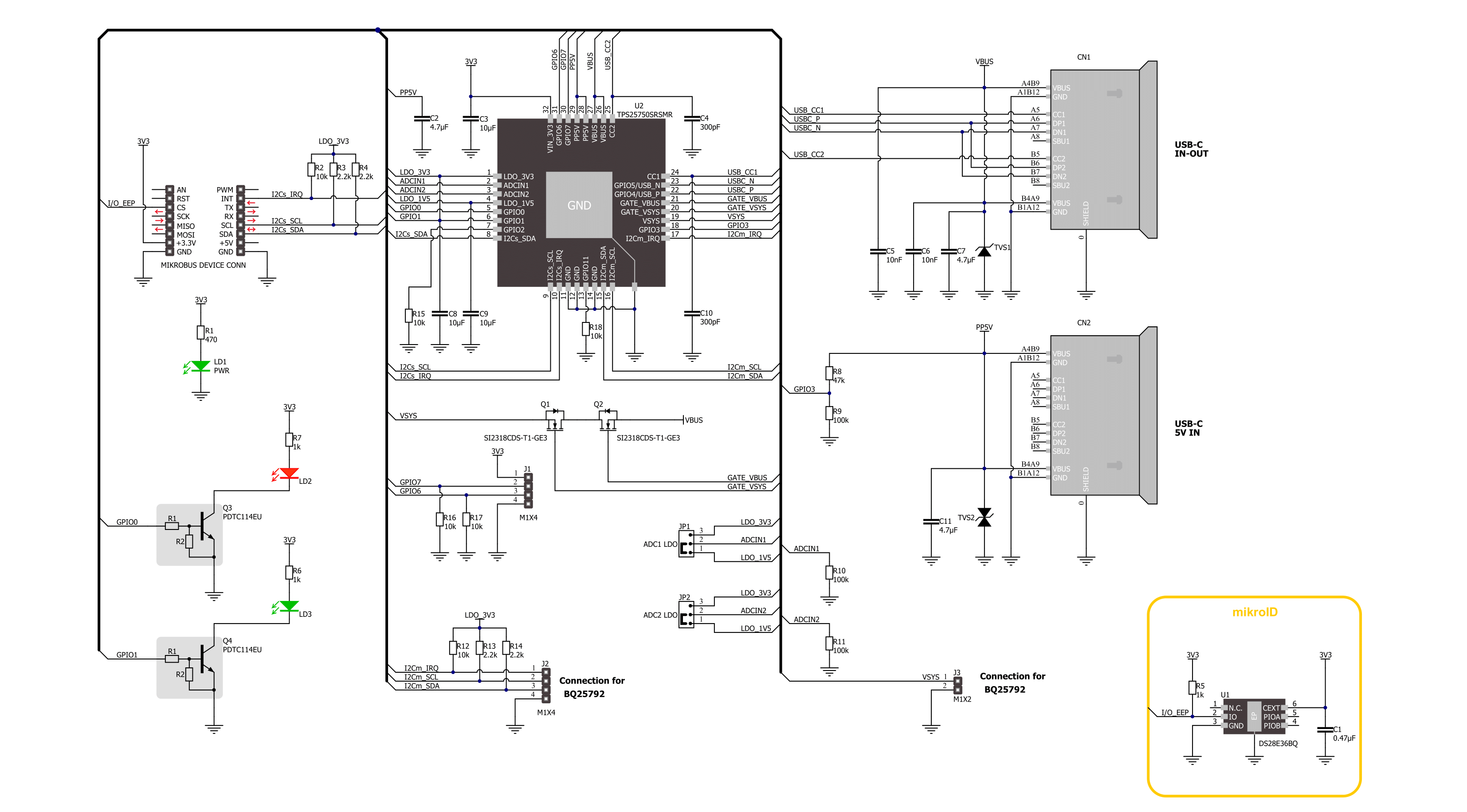
Step by step
Project assembly
Software Support
Library Description
This library contains API for USB-C Power Click driver.
Key functions:
usbcpower_get_status- USB-C Power gets status function.usbcpower_get_pwr_status- USB-C Power gets PWR status function.usbcpower_start_patch_burst_mode- USB-C Power starts the patch burst mode function.
Open Source
Code example
The complete application code and a ready-to-use project are available through the NECTO Studio Package Manager for direct installation in the NECTO Studio. The application code can also be found on the MIKROE GitHub account.
/*!
* @file main.c
* @brief USB-C Power Click example
*
* # Description
* This example demonstrates the use of the USB-C Power Click board™
* by configuring the PD controller to attempt to become a Power Source.
*
* The demo application is composed of two sections :
*
* ## Application Init
* The initialization of I2C module, log UART, and additional pins.
* After the driver init, the app executes a default configuration,
* depending on PD Device Mode, the app performs the patch bundle update tasks
* for loading a patch bundle in burst mode to the PD controller.
*
* ## Application Task
* The application display status information about
* the PD controller data role and power of the connection.
* Results are being sent to the UART Terminal, where you can track their changes.
*
* ## Additional Function
* - static void usbcpower_display_status ( void )
* - static void usbcpower_display_pwr_status ( void )
*
* @note
* For the advanced configuration, use the TPS25750 Application Customization Tool:
* https://dev.ti.com/gallery/search/TPS25750_Application_Customization_Tool
*
* @author Nenad Filipovic
*
*/
#include "board.h"
#include "log.h"
#include "usbcpower.h"
static usbcpower_t usbcpower;
static log_t logger;
static uint32_t response;
static usbcpower_status_t status;
static usbcpower_pwr_status_t pwr_status;
/**
* @brief USB-C Power display status function.
* @details This function display status information.
* @return Nothing.
* @note None.
*/
static void usbcpower_display_status ( void );
/**
* @brief USB-C Power display PWR status function.
* @details This function display power of the connection status information.
* @return Nothing.
* @note None.
*/
static void usbcpower_display_pwr_status ( void );
void application_init ( void )
{
log_cfg_t log_cfg; /**< Logger config object. */
usbcpower_cfg_t usbcpower_cfg; /**< Click config object. */
/**
* Logger initialization.
* Default baud rate: 115200
* Default log level: LOG_LEVEL_DEBUG
* @note If USB_UART_RX and USB_UART_TX
* are defined as HAL_PIN_NC, you will
* need to define them manually for log to work.
* See @b LOG_MAP_USB_UART macro definition for detailed explanation.
*/
LOG_MAP_USB_UART( log_cfg );
log_init( &logger, &log_cfg );
log_info( &logger, " Application Init " );
// Click initialization.
usbcpower_cfg_setup( &usbcpower_cfg );
USBCPOWER_MAP_MIKROBUS( usbcpower_cfg, MIKROBUS_1 );
if ( I2C_MASTER_ERROR == usbcpower_init( &usbcpower, &usbcpower_cfg ) )
{
log_error( &logger, " Communication init." );
for ( ; ; );
}
if ( USBCPOWER_ERROR == usbcpower_default_cfg ( &usbcpower ) )
{
log_error( &logger, " Default configuration." );
for ( ; ; );
}
usbcpower_set_patch_mode( &usbcpower, &response );
if ( USBCPOWER_RSP_OK != response )
{
log_error( &logger, " Go to Patch Mode." );
for ( ; ; );
}
uint8_t device_mode[ 6 ] = { 0 };
usbcpower_get_device_mode( &usbcpower, &device_mode );
log_printf( &logger, " PD Device Mode: %s\r\n", &device_mode[ 1 ] );
log_printf( &logger, "-----------------------------\r\n" );
Delay_ms ( 100 );
log_info( &logger, " Application Task " );
log_printf( &logger, "-----------------------------\r\n" );
Delay_ms ( 100 );
}
void application_task ( void )
{
if ( USBCPOWER_OK == usbcpower_get_status( &usbcpower, &status ) )
{
if ( USBCPOWER_OK == usbcpower_get_pwr_status( &usbcpower, &pwr_status ) )
{
usbcpower_display_status( );
log_printf( &logger, "- - - - - - - - - - - - - - -\r\n" );
usbcpower_display_pwr_status( );
log_printf( &logger, "-----------------------------\r\n" );
}
}
Delay_ms ( 1000 );
Delay_ms ( 1000 );
Delay_ms ( 1000 );
}
int main ( void )
{
/* Do not remove this line or clock might not be set correctly. */
#ifdef PREINIT_SUPPORTED
preinit();
#endif
application_init( );
for ( ; ; )
{
application_task( );
}
return 0;
}
static void usbcpower_display_status ( void )
{
if ( status.plug_present )
{
log_printf( &logger, " A plug is connected.\r\n" );
}
else
{
log_printf( &logger, " No plug is connected\r\n" );
}
if ( USBCPOWER_STATUS_NO_CONNECTION == status.conn_state )
{
log_printf( &logger, " No connection.\r\n" );
}
else if ( USBCPOWER_STATUS_PORT_DISABLED == status.conn_state )
{
log_printf( &logger, " Port is disabled.\r\n" );
}
else if ( USBCPOWER_STATUS_AUDIO_CONNECTION == status.conn_state )
{
log_printf( &logger, " Audio connection (Ra/Ra).\r\n" );
}
else if ( USBCPOWER_STATUS_DEBUG_CONNECTION == status.conn_state )
{
log_printf( &logger, " Debug connection (Rd/Rd).\r\n" );
}
else if ( USBCPOWER_STATUS_NO_CONNECTION_Ra == status.conn_state )
{
log_printf( &logger, " No connection, Ra detected (Ra but no Rd).\r\n" );
}
else if ( USBCPOWER_STATUS_RESERVED == status.conn_state )
{
log_printf( &logger, " Reserved (may be used for Rp/Rp Debug connection).\r\n" );
}
else if ( USBCPOWER_STATUS_CONNECT_NO_Ra == status.conn_state )
{
log_printf( &logger, " Connection present, no Ra detected.\r\n" );
}
else
{
log_printf( &logger, " Connection present, Ra detected.\r\n" );
}
if ( status.plug_orientation )
{
log_printf( &logger, " Upside-down orientation.\r\n" );
}
else
{
log_printf( &logger, " Upside-up orientation.\r\n" );
}
if ( status.port_role )
{
log_printf( &logger, " PD Controller is Source.\r\n" );
}
else
{
log_printf( &logger, " PD Controller is in the Sink role.\r\n" );
}
}
static void usbcpower_display_pwr_status ( void )
{
if ( pwr_status.pwr_conn )
{
log_printf( &logger, " Connection present.\r\n" );
}
else
{
log_printf( &logger, " No connection.\r\n" );
}
if ( USBCPOWER_PWR_STATUS_USB == pwr_status.type_c_current )
{
log_printf( &logger, " USB Default Current.\r\n" );
}
else if ( USBCPOWER_PWR_STATUS_TYPE_C_1_5A == pwr_status.type_c_current )
{
log_printf( &logger, " Type-C Current: 1.5 A\r\n" );
}
else if ( USBCPOWER_PWR_STATUS_TYPE_C_3_0A == pwr_status.type_c_current )
{
log_printf( &logger, " Type-C Current: 3.0 A\r\n" );
}
else
{
log_printf( &logger, "Explicit PD contract sets current.\r\n" );
}
if ( USBCPOWER_PWR_STATUS_CHG_ADV_DISABLE == pwr_status.charger_advertise )
{
log_printf( &logger, " Charger advertise disabled or not run.\r\n" );
}
else if ( USBCPOWER_PWR_STATUS_CHG_ADV_PROCESS == pwr_status.charger_advertise )
{
log_printf( &logger, " Charger advertisement in process.\r\n" );
}
else if ( USBCPOWER_PWR_STATUS_CHG_ADV_COMPLETE == pwr_status.charger_advertise )
{
log_printf( &logger, "Charger advertisement complete.\r\n" );
}
else
{
log_printf( &logger, "Reserved.\r\n" );
}
}
// ------------------------------------------------------------------------ END
Additional Support
Resources
Category:USB-C PD























